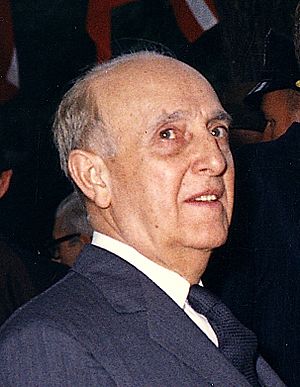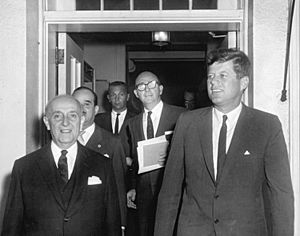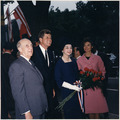Manuel Prado Ugarteche facts for kids
Quick facts for kids
Manuel Prado
|
|
|---|---|
 |
|
| 43rd and 46th President of Peru | |
| In office July 28, 1956 – July 18, 1962 |
|
| Vice President | Luis Gallo Porras Carlos Moreyra y Paz Soldán |
| Preceded by | Manuel A. Odría |
| Succeeded by | Ricardo Pérez Godoy |
| In office December 8, 1939 – July 28, 1945 |
|
| Vice President | Rafael Larco Herrera Carlos D. Gibson |
| Preceded by | Oscar R. Benavides |
| Succeeded by | José Bustamante y Rivero |
| Personal details | |
| Born | April 21, 1889 Lima, Peru |
| Died | August 15, 1967 (aged 78) Paris, France |
| Cause of death | Myocardial infarction |
| Political party | Pradist Democratic Movement |
| Spouses | Enriqueta Garland Higginson Clorinda Málaga de Prado |
| Children | 2 |
| Parents | Mariano Ignacio Prado María Magdalena Ugarteche Gutiérrez de Cossío |
| Profession | Banker |
Manuel Carlos Prado y Ugarteche (born April 21, 1889 – died August 15, 1967) was a Peruvian politician and banker. He served as President of Peru two times. His father, Mariano Ignacio Prado, was also a former president.
Manuel Prado was born in Lima, Peru. He was the 43rd president from 1939 to 1945. Later, he became the 46th president from 1956 to 1962. His brother, Leoncio Prado Gutiérrez, was a military hero.
Prado studied at college and became a banker. In 1914, he helped General Oscar R. Benavides overthrow President Guillermo Billinghurst. Peru stayed neutral during World War I at this time. Prado was later sent away to Chile and then lived in France.
He returned to Peru in 1932. He became the head of the Central Reserve Bank of Peru from 1934 to 1939. He won the 1939 elections. During his first time as president, Peru won a war against Ecuador. Peru also became the first South American country to stop relations with the Axis powers in World War II.
After his first term ended in 1945, he went to Paris. He came back to Peru and won the 1956 elections. This began his second time as president. He supported the United States during the Cold War. However, he was removed from power in a military takeover in 1962. He went back to Paris, where he passed away in 1967.
Contents
Manuel Prado's Life Story
Early Life and Education
Manuel Prado came from a well-known family. His father, Mariano Ignacio Prado, was a Peruvian President. His mother was María Magdalena Ugarteche Gutiérrez de Cossío. His father left Peru during the War of the Pacific with Chile. He was removed from power in 1879. Manuel's older brother, Leoncio Prado, was a hero in this war. He was shot by the Chileans in 1883.
Manuel studied at the College of the Immaculate. He then went to the University of San Marcos. He earned degrees in science and political science. He also studied at the National School of Engineers. He became a Civil Engineer in 1911.
As a university student, he also had military training. He became a cavalry officer. He joined the army when there was a threat of war with Ecuador in 1910. He also taught at the University of San Marcos.
Early Political Career
Manuel Prado joined the Civil Party when he was young. In 1914, he supported General Oscar R. Benavides. They led a takeover against President Guillermo Billinghurst. Prado was part of the group that entered the Government Palace. This action led to his promotion in the army. In 1915, he was elected to the Municipal Council of Lima. He helped design plans for improving the city.
Prado became president of the Associated Electric Companies. In 1919, he was elected as a deputy. He opposed President Augusto B. Leguía's plans to stay in power. Because of this, he was arrested in 1921. He was sent away to Chile and then lived in France until 1932. When he returned, he became the head of the Peruvian Vapores Company. He also led the Central Reserve Bank of Peru from 1934 to 1939.
The 1939 Election
For the 1939 election, President Oscar R. Benavides supported Manuel Prado as his chosen candidate. Another candidate was José Quesada Larrea. He bought a newspaper to campaign for fair elections.
The APRA party, a major political group, was not allowed to take part. Other important groups were also stopped from participating. Both Prado and Quesada asked for support from APRA members. However, APRA decided not to choose a side. Prado ran as a candidate for a group of smaller parties.
Before the election, the government closed Quesada's newspaper. When the votes were counted, Prado was announced as the winner by a large amount. Many people believed there was widespread cheating in the election.
First Time as President (1939-1945)
Manuel Prado became president on December 8, 1939. Many thought he would not stay in office for long. But he proved to be a very skilled politician. His government continued many of the plans of the previous president, General Oscar Benavides. It was a time of relative democracy.
This period was affected by World War II. Trade was greatly impacted. Imports decreased, but exports like sugar, cotton, metals, and rubber increased. The lack of imported goods led to new industries starting in Peru. The war also created many "new rich" people.
Key Achievements and Events
Prado had two big successes in international relations:
- The first was winning the war against Ecuador. They signed the Rio de Janeiro Protocol. This agreement aimed to solve a long-standing border dispute.
- The second was Peru's strong support for the United States and other democracies during World War II. Peru was the first country in Latin America to stop relations with the Axis powers (Germany, Italy, and Japan). Peru's stance encouraged other American countries to support the United States.
In Peru, Prado's government was seen as democratic. However, the Aprista Party remained outlawed for most of his term. It was only allowed to participate in the last year of his government. Many communists supported Prado because the Soviet Union was an ally of the United States.
Important Projects and Facts
Besides the war with Ecuador and supporting the Allies in World War II, Prado's first government completed many important projects:
- An "import substitution" plan was started. This meant making products in Peru that were usually imported. This helped Peru's industries grow.
- The Peruvian Amazon Corporation was created. Its goal was to boost the rubber industry, which was in high demand during the war.
- The Peruvian Commercial Aviation Corporation (CORPAC) was formed. It was in charge of airports. The Limatambo Airport was opened.
- An agreement with the United States helped agricultural development.
- The Peruvian part of the Pan American Highway was paved.
- The Central Road to Aguaytia and Pucallpa, in the jungle, was finished.
- The departments of Tumbes (1942) and Pasco (1944) were created.
- A General Census was held in 1940. It showed Peru had 6,207,966 people. About 577,000 lived in Lima.
- A new law for public education was passed. A national plan to teach people to read and write was started in 1943.
- Technical education was improved with better schools and equipment.
- New hospitals were opened, including the Worker's Hospital (now Guillermo Almenara Hospital) in Lima.
- Mass vaccination campaigns began to protect people's health.
- The fourth Working Quarter was built in Rimac.
- The Yavarí District was created in the Mariscal Ramón Castilla Province.
- Efforts to boost tourism continued.
- Popular canteens were created to provide food.
There were also two major disasters during this time. An earthquake hit Lima and Callao on May 24, 1940. The National Library of Peru caught fire on May 11, 1943. The historian Jorge Basadre was put in charge of rebuilding the library.
For the 1945 election, Prado supported General Eloy Ureta. Ureta was a hero from the war against Ecuador. However, the lawyer José Luis Bustamante y Rivero was more popular. He represented a group of parties, including APRA. Bustamante y Rivero won the election.
After his term, Prado moved to Paris. He owned a home there. In Lima, he owned the Edificio Rímac building.
Foreign Policy Decisions
Prado was proud that Peru was the first South American nation to break ties with the Axis Powers in 1942. He strongly supported the United States. During World War II, he also supported sending Peruvians of Japanese descent to the United States. Some historians believe this was an attempt to remove all Japanese-descended residents from Peru.
Second Time as President (1956-1962)
The elections were held on June 17, 1956. Manuel Prado Ugarteche won with 45.5% of the votes. Fernando Belaunde Terry came in second with 36.7%.

During Prado's second presidency, the APRA party was the only major party not allowed to operate. It had been outlawed in 1948 by President Manuel Odría. Prado announced that he would ask Congress to make APRA legal again. This bill was passed. APRA's famous founder, Víctor Raúl Haya de la Torre, returned from living outside the country.
This government faced many challenges, especially an economic crisis. There was also unrest in the countryside. People wanted land reform. There was a strong campaign to take back the La Brea and Pariñas oil fields. These fields were being operated illegally by an American company.
The architect Belaunde led the opposition. He formed a new party called People's Action. This party became very important in future elections. Newspapers like El Comercio and La Prensa also opposed the government. Prado's family owned a newspaper called La Crónica, but it focused more on sports.
The biggest economic problem was the budget. This was caused by a slowdown in the United States economy in 1957. The value of Peru's export products went down. Dollars became scarce, and the Peruvian currency lost value. Pedro G. Beltrán, the director of La Prensa, was appointed as Minister of Finance in 1959. His job was to fix the country's finances and balance the budget. He succeeded, but it meant raising gasoline prices, cutting food help, and increasing taxes.
During these years, many people moved from the mountains to Lima. Slums grew around the capital. Prado did not do much to improve the lives of most Peruvians, who continued to live in difficult conditions.
As his term ended, people were clearly unhappy. There were many strikes and loud protests in the streets. People criticized not only his economic policies but also his personality.
In his personal life, Prado's first marriage was ended by the Catholic Church in 1958. He then married Clorinda Málaga de Prado. This caused some talk among Lima's traditional society. In 1961, he was the first foreign leader to visit Japan after World War II.
Important Projects and Facts
Key achievements of Prado's second government include:
- The Industrial Promotion Act was passed. This law helped Peru's growing industries.
- The National Fund for Economic Development was created in each department. This helped fund public works and decentralize administration.
- A steel plant was built in the port of Chimbote. Peru hoped to grow its industry like other Latin American countries. Chimbote also became a very important fishing port.
- The fishmeal industry began to grow rapidly. Peru became the world's leading fishing power. This success was largely due to the businessman Luis Banchero Rossi.
- Peru strongly defended its rights against Ecuador's attempts to ignore the Rio de Janeiro Protocol of 1942.
- To address the demand for land reform, Prado created an Institute of Agrarian Reform and Colonization (IRAC). This group studied ways to increase farmed land and spread small and medium-sized farms.
- New naval ships, the BAP Almirante Grau and BAP Coronel Bolognesi, were bought. They replaced older ships and served until the 1980s.
- The Joint Command of the Armed Forces was created. This group brings together the leaders of the Army, Navy, and Air Force.
- Secondary education was reformed. From the fourth year, students chose between Letters and Sciences. Technical secondary education improved.
- Diplomatic relations with Cuba were ended after the Cuban Revolution turned communist.
- Peru joined the Alliance for Progress. This was a program led by U.S. President John F. Kennedy to help develop Latin America.
- An agreement was signed with Bolivia to use the waters of Lake Titicaca for irrigation.
- The 'Southern Plan' was developed to help the Puno Region. This area suffered a terrible drought in 1958-59.
- Television was introduced in Peru in 1958. The first TV stations soon appeared.
Removal by Military Takeover
At the end of his term, Prado called for elections. The main candidates were Victor Raul Haya de la Torre, Fernando Belaunde Terry, and former president Manuel A. Odría.
The elections were held on June 10, 1962. No candidate won the required one-third of the votes. This meant that Congress had to choose the president from the top three candidates. Many expected a deal between Haya de la Torre and Odría. However, the government was accused of cheating in some areas. The Joint Command of the Armed Forces, led by General Ricardo Pérez Godoy, demanded that the elections be canceled.
The Peruvian Armed Forces had been against Prado's government. They felt he focused too much on civilian life. This meant the military received less support from traditional groups. On July 18, 1962, military forces stormed the Government Palace. They arrested President Prado and his companions. Prado was taken to a naval ship and held there until his term ended on July 28. On August 1, he left Peru and moved to Paris.
A military government was formed. They canceled the elections and called for new ones. Many believe the military takeover happened because the armed forces did not want the APRA party to be in power.
Later Life
Prado lived in Paris after leaving Peru. He made a short visit back to Peru in 1966. This was to celebrate 100 years since the Battle of Callao. He was honored because his father, Mariano Ignacio Prado, led Peru during that conflict. Manuel Prado passed away in Paris the following year. He was buried in the Presbítero Maestro Cemetery, next to his father.
Images for kids
-
Prado with Queen Juliana during a state visit.
-
Prado with his wife, President John F. Kennedy, and Kennedy's wife.
See also
 In Spanish: Manuel Prado Ugarteche para niños
In Spanish: Manuel Prado Ugarteche para niños
- Ecuadorian–Peruvian War






